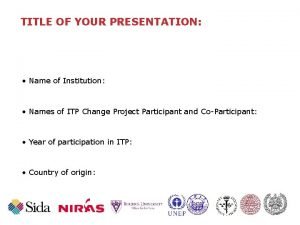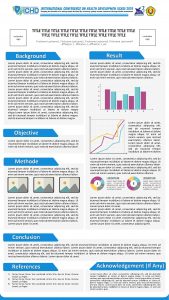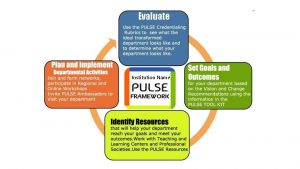TITLE OF YOUR PRESENTATION Name of Institution Names















- Slides: 15

TITLE OF YOUR PRESENTATION: • Name of Institution: • Names of ITP Change Project Participant and Co-Participant: • Year of participation in ITP: • Country of origin:

Research informing the Reflexive Learning Model of the ITP • We have worked with an emergent theory of social change to design the ITP curriculum • It involves • 1) giving attention to understanding of context and structural conditions; • 2) engaging in socio-cultural learning interactions - across contexts and in own context to stimulate processes of ‘learning to change’ and the agency of course participants in their contexts; and • 3) reflections on the changes to understand them within spheres of influence (positions and practices)

ITP Learning Programme Design (using Archer’s morphogenetic theory as lens to trace structural conditions (T 1) at start; social interactions during the training programme (T 2 -3) and changes in contexts, programmes, practices and conditions (T 2 -4): Elaboration of existing context through mobilisation of agency T 1…socio-cultural conditioning SOCIO-CULTURAL / SOCIAL ECOLOGICAL CONTEXT T 2 -T 3…social interaction TRAINING EXPERIENCES International exchange Situating learning and training (Auditing and review of context and practice) programme: Sweden using USAT: Basis of the (Africa-Asia); South ‘Change Project’ Africa (Regional) Network engagement Changes at institutional level? T 2 -T 4…elaborations / stasis WORKPLACE CHANGES Self-defined change project work (includes materials development) Institutional workshops (x 2) & Reporting Changed practices Changed practice Reflexivity and professional development

EXAMPLE: Uganda- Buisitema University Integrating ESD into curriculum development and teaching practices in Science Education Faculty T 1…Phase 1 New University, Multi campus T 2 -T 3…Phase 2&4 (Sweden / SA) Faculty wide audit using USAT, project Curriculum review change into curriculum Proactive National ESD development infusing strategy framework community engagement (SL) University Strategic Plan holistic approach Cross cutting module to building sustainable on ESD for Bachelor in future Science Education Programme T 2 -T 4…Phase 3, 4, 5 New cross-cutting curriculum module Engaging University Management and gaining full support Other stakeholder workshops included students and community through RCE

Enhancing Systemic Contextual Understanding: The USAT TOOL Background to its development What informed the design • An outcome of Ph. D research • Developed within the MESA Partnership Background • Supporting MESA implementation • MESA implementation phase 1 observations • reliance on individual change agents • lack of a systems approach at university level • Motivation Phase 1 key lessons • The need for a systems approach • The need for tools to support such an approach • Developing a tool that can support a whole systems approach to sustainability mainstreaming • Designing a tool that is relevant to the MESA universities partnership and that supports Aims and university-wide approach to sustainability objectives implementation • To strengthen the MESA programme toolkit and associated activities Environment Theories -Critical Realism -Systems thinking -Context Other SATs -SAQ -AISHE -GASU USAT -Sustainability declarations

The design of the tool Key design features Flexibility of use: Unit versus whole • teaching departments • University operational divisions USAT Parts Inclusive of various university sections Indicatorbased • Students, management (staffing), policy etc in addition to common functions like teaching, research and CE • Benchmarkin g, comparative analysis, progress USAT Indicators Areas identified as crucial for universities interested in mainstreaming sustainability to get engaged in Indicators More Indicators can be indicators should be modified can be treated as depending identified, guidelines on context and added Indicators found to be inapplicable to a certain context can be omitted in the assessment USAT Part A: Curriculum, Teaching approaches, Research, Community Service, Examinations, Staff Expertise USAT Part B: Operations and Management USAT Part C: Students Involvement Whole institution USAT Part D: Policy and written statements

Using the USAT f d o t, a e n H tme t or r a dep y, uni rs by o e t t l a m ic facu gram etc. f ind e score o o g , h r pr Ratin leting t rts B to ato n i d p a r com & for P coo the g s t n i e n she explai t can i w o D; nd h , etc. a y t i d activ improve be e n th o ed Bas core X s -Interviews -Content analysis (documents, websites, etc. ) -Observations

USAT data use Data usage Significance Providing guidelines and targets for sustainability mainstreaming Assessing progress Benchmarking initiatives Sustainability reporting Strengthening reflexive learning The USAT was a learning tool which enabled participants to get an understanding of the range of practices universities can get involved in The USAT was a decision-making tool which enabled participants to reflect on their practices thereby informing change projects Assessment results provided good quality starting points for change projects Assessment data collected before change project implementation could be used as baseline data enabling ongoing assessment of progress. Sharing of USAT analysis results enabled participants to learn from each other

Reflections on the use of the USAT tool in the ITP • Mandy – Useful tool that provides the institutions with a visual representation of the status quo. Provides decision makers with a bases to take action. • Vanessa – It provides evidence of situated sustainable/unsustainable practices. It provides a clear justification for change and the needed kind of change in the audited Institution/Faculty or Department. It is therefore a gateway to the start-up of urgent institutional need-based ESD mainstreaming. • Mucha – The tool has been used in other ways not anticipated during it’s development, e. g. the varied / flexible meaning of “unit” (a degree programme, a department, or a faculty) and the use of indicators as guidelines, not only to improve practices, but to identify / define new sustainability practices which institutions could implement. • Heila – Useful for institutionally locating the change process (not just the problem of 1 person); Very useful tool for ongoing monitoring and evaluation of ESD implementation over time

Understanding change processes over time: ITP Tracking Research • Three phases of Ph. D research • Phase ITP Tracking and development of ITP database Phase 1 -1: ITP tracking research (Asia and Africa) • Phase 1 -3: and Sources of data and time frame Participants co-participants names Phase 2 – Morphogenetic and position-practice system analysis • Institutions • Document Categories of change project(2008 -2013); innovation and ESD mainstreaming • review - ITP (Africa); reports • Countries • assisted surveyand questionnaire • Computer Institutional context ‒ Category A: New Policies Strategies (2013 – Africa and Phase 3 –project Deepertitle morphogenetic and position-practice system Asia participants) • Change ‒ Category B: laminated New Management Practices of Swaziland, analysis and system explanation Change project starting point and process of implementation • Self-administered semi structured questionnaires (31 African ‒ Category C: New Tools and Methods Zambia andof. Botswana ITP participants and MESA Chairs • participants Outcome change project implementation in SA-2013); ‒ Category D: New Programmes and Courses (Southern Africa). • Individual Determining the category of change project • interviews (3 participants in 2012 & 19 participants • in Further action plan on. Zambia, change Botswana); project 2014 – Swaziland, In addition to • The Relevance to. Category the short. A-D: and long term objectives of the ITP. • internet, University websites, institutional documents and ‒ Category E: New structures and networks and global documents. ‒ national, Category regional F: Internationalisation

PHASE ONE ITP TRACKING RESEARCH (AFRICA AND ASIA) MORH. AND POSITION-PRACTICE SYSTEM & ESD MAINSTREAMING (AFRICA) PHASE TWO PHASE POSITION-PRACTICE SYSTEM, MORPHOGENETIC ANALYSIS & LAMINATED SYSTEM EXPLANATION (SOUTHERN AFRICA) THREE TOTAL ASIA AFRICA COUNTRIES 35 12 23 NORTH WEST AFRICA (3) (4) CENTRAL EAST AFRICA (1) (4) SOUTHERN AFRICA (11) SUDAN LIBERIA CAMERO- KENYA SWAZILAND, ZAMBIA, EGYPT NIGERIA ON UGANDA BOTSWANA, MALAWI, MORO- GAMBIA ETHIOPI- MADAGASCAR, NAMIBIA, CCO A SENEGAL MAURITIUS, TANZANIA, RWANDA MOZAMBIQUE, SEYCHELLES, SOUTH AFRICA HEIs 108 PARTICIPAN 283 40 68 119 164 6 HEIs: UNISWA; UNZA, CBU, NIPA, KCo. E, UB 17 ITP + 3 MESA CHAIRS 58 83 9 change projects TS CHANGE P 141 Understanding change processes over time: Phases of Ph. D Research

About position-practice system - Phase 2 -3 research SOCIAL STRUCTURE HUMAN AGENCY . MEDIATING SYSTEM CALLED POSITIONPRACTICE SYSTEM The position-practice mediating system involves “the positions (places, functions, rules, tasks, duties, rights, etc. ) occupied (filled, assumed, enacted etc. ) by individuals, and of the practices (activities etc. ) in which, in virtue of their occupancy of these positions (and vice versa), they engage”

Phase 2 -3: Position-Practice System (P&PS) = Sphere of influence POSITIONS IN UNIVERSITIES Chancellor Vice-Chancellor Deputy Vice. Chancellor Ø Registrar Bursar Dean of Students Librarian Deans of Faculty Deputy/Assistant Dean Directors of Directorate, Centre, Institute, and Unit Head of Department (HOD)/ Unit Deputy Head of Department Senior lecturer Junior lecturer Students Representatives Students Casual workers Top/Senior/Executive Management (P&PS): Chancellor, Vice-Chancellor, Deputy Vice- Chancellor Implication of position-practice system for effective ITP ESD mainstreaming HEIs: Other top/senior management (P&PS) Registrar, Bursar, Dean of Students, Dean of The choice/kind of change project proposed by Schools or Faculties, Deputy/Assistant Dean, a participant and the expectation the Liberian, Director on of Directorate/Institute/Centres participants to implement such should be based Others (P&PS): of Department, Head on the sphere of influence associated with. Head their of Unit, Deputy Head of Department, Senior position-practice system (Evident in most Lecturer, Lecturer African cases). Ø Effective mainstreaming of ESD in HEIs is Others (P&PS): Lecturer, Senior enabled/constrained by the P&PS of not Junior just the Instructor, Employed ITP participants but the Researchers, P&PS of others Administrative and support Staff Ordinary Stockholders (P&PS): Casual in/outside their institution e. g. MESA Chairs, VC, workers - Lawn movers, Cleaners, Messengers Colleagues, Min of Education, Min of Environment etc. (Evident in all 3 countries).

Phase 3: Laminated System 7. The planetary-level (or cosmological) level Global trends and Why use the laminated 7 system for understanding and explaining ESD? responses. Implication of morphogenetic and position-practice Ø A system that refers essentially to 6. The mega-level of the system analysis, and laminated system explanation for several different levels of reality in analysis of whole ESD mainstreaming an in HEIs: open system traditions and civilizations 6 Ø The constitution of a laminated system analytically Ø Social events are systemic in – Continental issues enables the visibility and explanation of the obvious nature and the reference to any 5. The macro-level multiplicity and complexity of ESD issues stemming system at one or any level will orientated to the out of each level, necessitate context and scale. the compulsory 5 understanding of the involvement and reference to the functioning of whole others. Ø The characteristics of individuals at level 1 -3, and societies or their regions – Ø Cognisance of the 4 -5 existing the characteristics of the society at level and Africa hierarchy of scale of social planetary issues/risks/responses at level 6 -7 events all 4 4. The meso-level at – more macroscopic or overlying shape the status of ESD – Why leave out an which we are concerned andlevel? less macroscopic and efficacious with the relations between underlying. Ø Seven-scalar social being - enables functional roles –countries Ø Investigating, monitoring and analysing individual the possibility of 3 social 3. The micro-level studied learning and change process, explanation at seven distinct levels - Institutions collective/institutional learning process of agencyand andchange collectivity that 2. The individual level or and socio-cultural/Socio-ecological changes – social life are concerned 2 with or biophysical level – especially after professional capacity development related to. Material circumstance of agents, which are essential to effective ESD, is 1. The sub-individual-level possible! 1 psychological level – Identity, personality

Summary … ITP Learning and Change in socialecological relationships and context Institutional Change Personal Professional Change
 Formal institution and informal institution
Formal institution and informal institution What's your name is
What's your name is Institution title
Institution title Title and institution
Title and institution The name above all names lyrics
The name above all names lyrics Insert the sub title of your presentation
Insert the sub title of your presentation This is your presentation title
This is your presentation title This is your presentation title
This is your presentation title What is a transition headline
What is a transition headline This is your presentation title
This is your presentation title Copydroid
Copydroid Institution name example
Institution name example The institution herein
The institution herein Name of presentation company name
Name of presentation company name Name of presentation company name
Name of presentation company name Title names
Title names





























